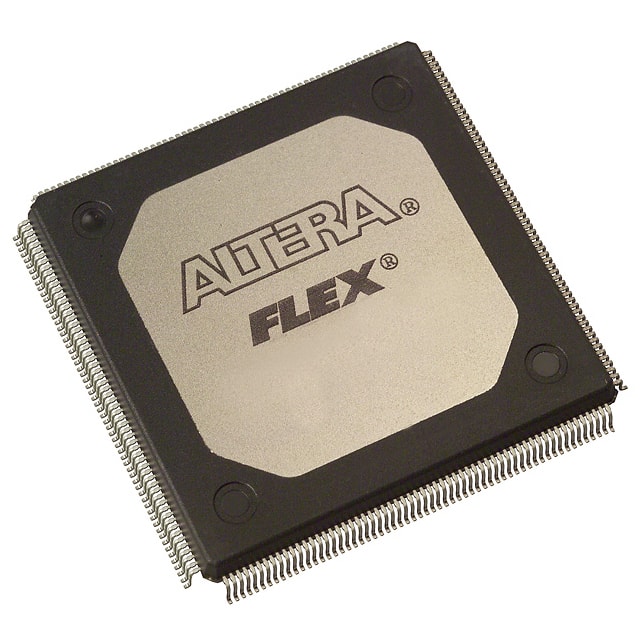Viz Specifikace pro podrobnosti o produktu.

EPF10K50VRI240-3N
Product Overview
Category: Programmable Logic Device (PLD)
Use: The EPF10K50VRI240-3N is a high-performance PLD designed for various digital logic applications. It offers flexible programmability and advanced features to meet the requirements of complex designs.
Characteristics: - High-density integration - Low power consumption - Fast performance - Extensive I/O capabilities - Versatile design options
Package: The EPF10K50VRI240-3N comes in a compact and durable package, ensuring easy handling and protection during transportation and installation.
Essence: This PLD is an essential component in electronic systems that require customizable logic functions and high-speed data processing.
Packaging/Quantity: The EPF10K50VRI240-3N is typically packaged individually and is available in various quantities depending on the customer's needs.
Specifications
- Logic Elements: 50,000
- Maximum User I/Os: 240
- Operating Voltage: 3.3V
- Speed Grade: -3
- Maximum Frequency: 240 MHz
- Embedded Memory: Up to 1,152 Kbits
- Package Type: VQFP
- Package Pins: 240
Detailed Pin Configuration
The EPF10K50VRI240-3N has a well-defined pin configuration that facilitates easy integration into circuit designs. The detailed pin configuration can be found in the product datasheet provided by the manufacturer.
Functional Features
- Flexible Logic Blocks: The device offers a large number of configurable logic blocks, allowing designers to implement complex logic functions efficiently.
- Dedicated Input/Output Resources: The PLD provides abundant I/O resources, including general-purpose I/O pins, clock inputs, and specialized interfaces such as memory controllers and serial communication ports.
- Programmability: The EPF10K50VRI240-3N can be programmed using industry-standard hardware description languages (HDLs) and development tools, enabling designers to create custom logic designs tailored to their specific requirements.
- High-Speed Performance: With a maximum operating frequency of 240 MHz, this PLD is capable of handling demanding real-time applications.
Advantages and Disadvantages
Advantages: - High integration density allows for complex designs in a compact form factor. - Low power consumption contributes to energy-efficient systems. - Versatile I/O capabilities enable seamless interfacing with other components. - Fast performance ensures efficient data processing.
Disadvantages: - Limited availability of alternative models may restrict design options. - Initial learning curve required to effectively utilize the device's programmability features.
Working Principles
The EPF10K50VRI240-3N operates based on the principles of field-programmable gate arrays (FPGAs). It consists of configurable logic blocks interconnected through programmable routing resources. These logic blocks can be programmed to implement various digital logic functions, allowing designers to create custom circuits without the need for dedicated hardware.
Detailed Application Field Plans
The EPF10K50VRI240-3N finds applications in a wide range of fields, including but not limited to: - Telecommunications - Industrial automation - Consumer electronics - Automotive systems - Medical devices
In telecommunications, it can be used for signal processing, protocol conversion, and network interface control. In industrial automation, it enables flexible control and monitoring of manufacturing processes. In consumer electronics, it supports advanced multimedia processing and user interface functionalities. In automotive systems, it facilitates vehicle control and driver assistance systems. In medical devices, it aids in data acquisition and analysis for diagnostics and treatment.
Detailed and Complete Alternative Models
While the EPF10K50VRI240-3N offers a comprehensive set of features, there are alternative models available in the market that cater to different design requirements. Some notable alternatives include: - EPF10K20RC240-4: A lower-density PLD suitable for less complex designs. - EPF10K200SFC484-2: A higher-density PLD with increased logic elements and I/O capabilities. - EPF10K100ABC356-1: A PLD optimized for low-power applications.
These alternative models provide designers with additional options to choose from based on their specific project needs.
Word count: 515 words
Seznam 10 běžných otázek a odpovědí souvisejících s aplikací EPF10K50VRI240-3N v technických řešeních
Sure! Here are 10 common questions and answers related to the application of EPF10K50VRI240-3N in technical solutions:
Question: What is EPF10K50VRI240-3N?
- Answer: EPF10K50VRI240-3N is a specific model of Field Programmable Gate Array (FPGA) manufactured by Intel.Question: What are the key features of EPF10K50VRI240-3N?
- Answer: Some key features include 50,000 logic elements, 240-pin package, and support for various I/O standards.Question: In what applications can EPF10K50VRI240-3N be used?
- Answer: EPF10K50VRI240-3N can be used in a wide range of applications such as telecommunications, industrial automation, medical devices, and aerospace.Question: How does EPF10K50VRI240-3N benefit telecommunications applications?
- Answer: EPF10K50VRI240-3N offers high-speed processing capabilities, flexibility, and scalability, making it suitable for tasks like signal processing, protocol handling, and network management.Question: Can EPF10K50VRI240-3N be used in safety-critical applications?
- Answer: Yes, EPF10K50VRI240-3N can be used in safety-critical applications with proper design considerations and adherence to relevant industry standards.Question: What tools are available for programming EPF10K50VRI240-3N?
- Answer: Intel provides Quartus Prime software suite, which includes tools for designing, simulating, and programming EPF10K50VRI240-3N.Question: Can EPF10K50VRI240-3N interface with other components or devices?
- Answer: Yes, EPF10K50VRI240-3N supports various I/O standards and can interface with other components such as sensors, actuators, memory devices, and communication interfaces.Question: What are the power requirements for EPF10K50VRI240-3N?
- Answer: EPF10K50VRI240-3N typically requires a supply voltage of 2.5V or 3.3V, depending on the specific design requirements.Question: Are there any limitations or considerations when using EPF10K50VRI240-3N?
- Answer: Some considerations include power consumption, thermal management, and proper signal integrity practices to ensure reliable operation.Question: Where can I find more information about EPF10K50VRI240-3N?
- Answer: You can refer to the official documentation provided by Intel, including datasheets, application notes, and user guides. Additionally, online forums and communities dedicated to FPGA development can be helpful sources of information.

